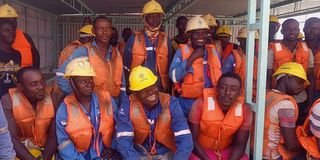Youths, local industries to reap more from Lapsset project

Some of the youths working at the Kililana site of the Lamu Port-South Sudan-Ethiopia-Transport Corridor Project, as pictured during an inspection tour on November 24, 2018. PHOTO | KALUME KAZUNGU | NATION MEDIA GROUP
What you need to know:
- LCDA Chief Executive Officer Silvestre Kasuku reported on Saturday that more than 1,000 Kenyans, mostly from Lamu, have been employed so far.
- The construction of the first three berths, which cost the government Sh48 billion, is 60 percent complete.
- Some of the workers who were interviewed at the port said they were happy with project outcomes.
The Lapsset Corridor Development Authority (LCDA) has pledged more jobs for local youths with the second phase of dredging and construction of the first three berths at the site in Kililana, Lamu West.
LCDA Chief Executive Officer Silvestre Kasuku reported on Saturday that more than 1,000 Kenyans, mostly from Lamu, have been employed so far.
MORE JOBS
Mr Kasuku said it is expected that more youths will be hired in the coming years, especially when dredging, reclamation, the construction of other berths and the implementation of other project components kicks off.
The Sh2.5 trillion project plan includes a 32-berth port; transportation hubs for rail, highways and international airports in Lamu, Isiolo and Lodwar; an oil pipeline from South Sudan, Uganda and Ethiopia to Lamu port; an oil refinery and three resort cities in Isiolo, Lamu and Turkana.
The construction of the first three berths, which cost the government Sh48 billion, is 60 percent complete.
The cost includes the physical construction of the three Lapsset terminals as well as activities such as preparation of the turning bay, dredging and reclamation, and navigation of sea waves.

Silvestre Kasuku, the chief executive of the Lapsset Corridor Development Authority, addresses some of the youths working at the Kililana site of the Lamu Port-South Sudan-Ethiopia-Transport Corridor Project during an inspection tour on November 24, 2018. PHOTO | KALUME KAZUNGU | NATION MEDIA GROUP
LIVES IMPROVED
Mr Kasuku, who spoke during an inspection tour on Saturday, noted that the project has improved many lives.
“It has created a lot of jobs for Kenyans, most of whom are local youths from Lamu," he said, and asked young people across the country to equip themselves with skills that will enable them secure jobs at the port.
“We are employing new and advanced technology in building the port. The port is being constructed at the sea through dredging and reclamation, which machines and manpower. That’s why enough people have been deployed and more will be sourced."
The CEO said materials being used at the port construction are sourced locally to benefit industries.
“That means that cement, steel and other industries n Kenya are benefiting," he said.
GOOD REPORTS
Some of the workers who were interviewed at the port said they were happy with project outcomes.
Mr Simon Mwangi, a wielder, said he searched for a job for years after graduating from a local polytechnic.
“I had lost the hope of getting a job in Kenya but thanks to the Lapsset project, I now work here," said Mr Mwangi.
Mr George Kitsao, a mason from Kilifi County, said, “The port has come with many goodies. Our standards of living have generally improved since we secured jobs. We are now able to take good care of our families,” said Mr Kitsao.
The port is projected to be the largest port in Kenya, East and Central Africa.
Apart from the construction of the first three berths at Kililana, the government is pursuing the development of road connections. Lamu-Garsen and Lamu-Garissa-Isiolo roads will connect the port to the rest of the Lapsset corridor, parts of the country and
several areas outside Kenya.
According to the LCDA, the first berth will have been completed by June 30, 2019 while the other two berths will be ready by the end of 2020.





